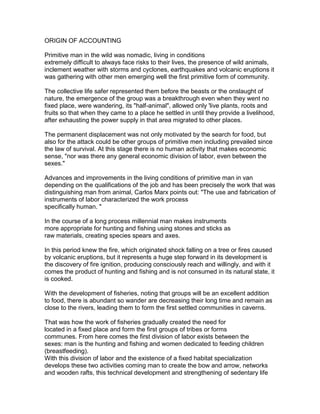
Origin of Accounting - How Early Man's Tracking of Resources Led to Accounting
- 1. ORIGIN OF ACCOUNTING Primitive man in the wild was nomadic, living in conditions extremely difficult to always face risks to their lives, the presence of wild animals, inclement weather with storms and cyclones, earthquakes and volcanic eruptions it was gathering with other men emerging well the first primitive form of community. The collective life safer represented them before the beasts or the onslaught of nature, the emergence of the group was a breakthrough even when they went no fixed place, were wandering, its "half-animal", allowed only 'live plants, roots and fruits so that when they came to a place he settled in until they provide a livelihood, after exhausting the power supply in that area migrated to other places. The permanent displacement was not only motivated by the search for food, but also for the attack could be other groups of primitive men including prevailed since the law of survival. At this stage there is no human activity that makes economic sense, "nor was there any general economic division of labor, even between the sexes." Advances and improvements in the living conditions of primitive man in van depending on the qualifications of the job and has been precisely the work that was distinguishing man from animal, Carlos Marx points out: "The use and fabrication of instruments of labor characterized the work process specifically human. " In the course of a long process millennial man makes instruments more appropriate for hunting and fishing using stones and sticks as raw materials, creating species spears and axes. In this period knew the fire, which originated shock falling on a tree or fires caused by volcanic eruptions, but it represents a huge step forward in its development is the discovery of fire ignition, producing consciously reach and willingly, and with it comes the product of hunting and fishing and is not consumed in its natural state, it is cooked. With the development of fisheries, noting that groups will be an excellent addition to food, there is abundant so wander are decreasing their long time and remain as close to the rivers, leading them to form the first settled communities in caverns. That was how the work of fisheries gradually created the need for located in a fixed place and form the first groups of tribes or forms communes. From here comes the first division of labor exists between the sexes: man is the hunting and fishing and women dedicated to feeding children (breastfeeding). With this division of labor and the existence of a fixed habitat specialization develops these two activities coming man to create the bow and arrow, networks and wooden rafts, this technical development and strengthening of sedentary life
- 2. sat the basis for the emergence of agriculture and domestic culture expressed in drawings engraved on the walls of caves and symbolized the struggle of man against beast or worshiping gods and now several of remarkable development in the history of mankind the conditions for the existence of the first form of property, social property, and with it the appearance of the first demonstrations accounting sense, the members of a group working together, organized fishing or hunting brigades and at that time a man alone, isolated against forces of nature or against rival tribes was impossible survived, also, the work product was also distributed evenly all and, thus appearing in social ownership history.